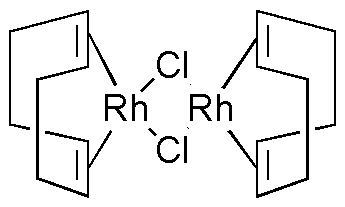Bis(1,5-cyclooctadiene)dirhodium(I) dichloride is widely utilized in research focused on:
- Catalysis: This compound serves as an effective catalyst in various organic reactions, particularly in the formation of carbon-carbon bonds, making it invaluable in synthetic organic chemistry.
- Homogeneous Catalysis: Its ability to facilitate reactions under mild conditions allows for more efficient processes in the pharmaceutical industry, leading to reduced energy consumption and waste.
- Polymerization: It is used in the polymerization of certain monomers, aiding in the production of high-performance materials that are crucial in the plastics and coatings industries.
- Research in Organometallic Chemistry: The compound is a key subject of study for researchers exploring metal-ligand interactions, which can lead to the development of new catalysts and materials.
- Environmental Applications: Its catalytic properties are being investigated for applications in green chemistry, particularly in the reduction of pollutants and the synthesis of environmentally friendly products.
General Information
Properties
Safety and Regulations
Applications
Bis(1,5-cyclooctadiene)dirhodium(I) dichloride is widely utilized in research focused on:
- Catalysis: This compound serves as an effective catalyst in various organic reactions, particularly in the formation of carbon-carbon bonds, making it invaluable in synthetic organic chemistry.
- Homogeneous Catalysis: Its ability to facilitate reactions under mild conditions allows for more efficient processes in the pharmaceutical industry, leading to reduced energy consumption and waste.
- Polymerization: It is used in the polymerization of certain monomers, aiding in the production of high-performance materials that are crucial in the plastics and coatings industries.
- Research in Organometallic Chemistry: The compound is a key subject of study for researchers exploring metal-ligand interactions, which can lead to the development of new catalysts and materials.
- Environmental Applications: Its catalytic properties are being investigated for applications in green chemistry, particularly in the reduction of pollutants and the synthesis of environmentally friendly products.
Documents
Safety Data Sheets (SDS)
The SDS provides comprehensive safety information on handling, storage, and disposal of the product.
Product Specification (PS)
The PS provides a comprehensive breakdown of the product’s properties, including chemical composition, physical state, purity, and storage requirements. It also details acceptable quality ranges and the product's intended applications.
Certificates of Analysis (COA)
Search for Certificates of Analysis (COA) by entering the products Lot Number. Lot and Batch Numbers can be found on a product’s label following the words ‘Lot’ or ‘Batch’.
Número de catálogo
Número de lote/lote
Certificates Of Origin (COO)
This COO confirms the country where the product was manufactured, and also details the materials and components used in it and whether it is derived from natural, synthetic, or other specific sources. This certificate may be required for customs, trade, and regulatory compliance.
Número de catálogo
Número de lote/lote
Safety Data Sheets (SDS)
The SDS provides comprehensive safety information on handling, storage, and disposal of the product.
DownloadProduct Specification (PS)
The PS provides a comprehensive breakdown of the product’s properties, including chemical composition, physical state, purity, and storage requirements. It also details acceptable quality ranges and the product's intended applications.
DownloadCertificates of Analysis (COA)
Search for Certificates of Analysis (COA) by entering the products Lot Number. Lot and Batch Numbers can be found on a product’s label following the words ‘Lot’ or ‘Batch’.
Número de catálogo
Número de lote/lote
Certificates Of Origin (COO)
This COO confirms the country where the product was manufactured, and also details the materials and components used in it and whether it is derived from natural, synthetic, or other specific sources. This certificate may be required for customs, trade, and regulatory compliance.


